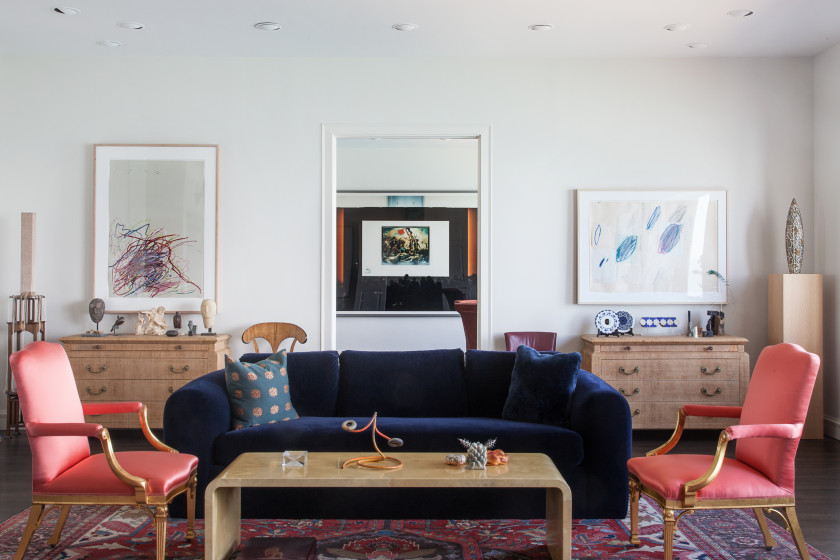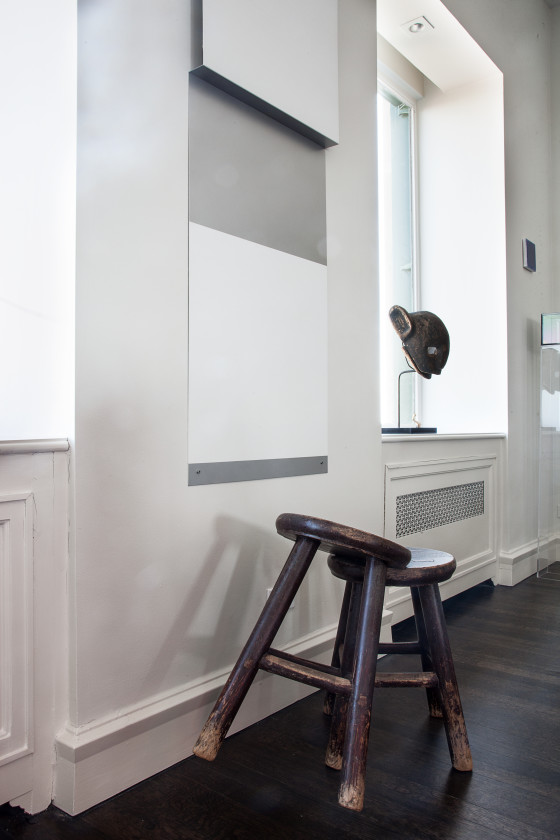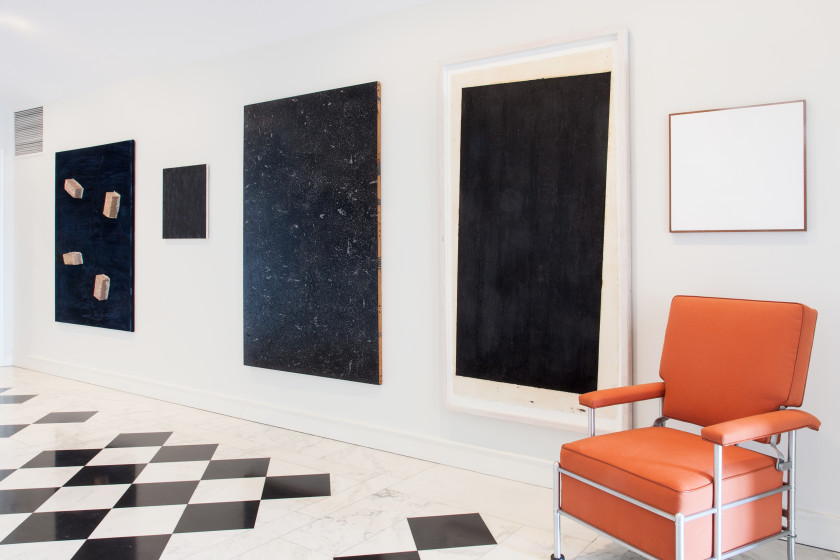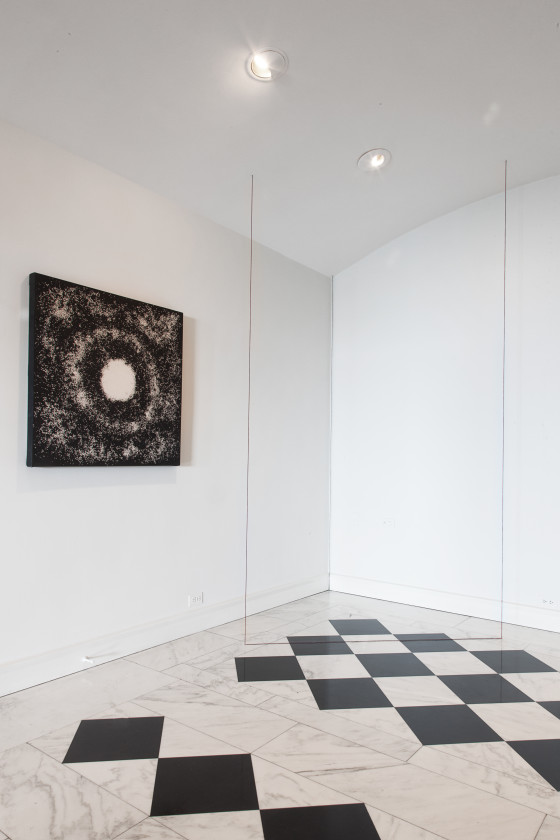Collector’s Corner: Helyn Goldenberg
by Katy Donoghue

Art is the first thing you will see when walking in to Helyn Goldenberg’s apartment on Lakeshore Drive in Chicago. In the entryway alone is a set of Ai Weiwei Ming Dynasty pots, their bright colors aligned side by side, on what would typically be a mundane mail table in anyone else’s front room. Entering the foyer, with its curved ceilings and black and white tiling, the space is home to a Rashid Johnson, a Takesada Matsutani, and a Fred Sandback yarn installation, framing the far left corner. In just a few feet, we understand that we are in the presence of an astounding collection—one with a varied history, focused on a multitude movements and media throughout the years; Minimalism, Abstract Expressionism, Pop, and international contemporary works intertwine—all reflective of Goldenberg’s experience, with over three decades in the space, and whose affinity for art she shares with her husband Michael Alper.
Did we mention the wall-to-wall, uninterrupted view of the lake from her living and dining room? When Goldenberg noticed our admiration, she pointed toward a small Calder sculpture on the window’s ledge. It could not have been more than six inches high. “Don’t you love that?” she asks. How could we not?
To our right is a series of ceramic vessels by Chicago-based artist William J. O’Brien—a colorful, uneven glaze covering the surface of their irregular form—followed by a pairing of Brice Marden and Ellsworth Kelly paintings, framing the doorway to a library. The two iconic Minimalists share in this context a conversation between form and color; Marden’s even blue and yellow stripes soberly set in a vertical composition, while Kelly’s curved edge plays with figure and ground in swaths of yellow and orange. In the library, is a small Yayoi Kusama, the first piece Goldenberg bought on her own after starting at Sotheby’s, where she’s been since 1987, and is now the Midwest-based director of its worldwide Contemporary Art Division.
What was most striking about walking around with Goldenberg, was the apparent accumulation of objects over the years—painting, sculpture, drawings, furniture—all of which she could name (Kerry James Marshall, Michelle Grabner, Wim Delvoye, Andy Warhol, Christopher Wool, Nick Cave, Cy Twombly, Blinky Palermo, it went on and on) and how these acquisitions each acted as a marker of a moment within her own history, which includes time as chairman of Performing Arts Chicago, Sculpture Chicago, the MCA (where she still sits on the board), running the ahead-of-its-time National Arts Guide, and now as President of The Arts Club of Chicago.
After touring us through the installation, and being sure to point out the original pre-war icebox she’d brought up-to-date in the kitchen, we sat down to discuss the evolution of her collection, and why she prefers to not be called a collector, but rather, amateur.
KATY DONOGHUE: I wanted to start with asking what role the arts played early on in your life—was it something you grew up around in Chicago?
HELYN GOLDENBERG: I was a theater major, so I was always into the arts. I have always been involved in things that were visual. But what really happened to me is I married an art dealer. I married Bud Holland. One of the reasons we got together was I liked art. We had a mutual relationship and he was a mentor to me. What I like to say is, everybody’s hobby became my business. And my business was also my hobby.
KD: When you first were with Holland, you collected Abstract Expressionism together. Was there a point at which you started to feel like you were building a collection, per se?
HG: You know—I never think of a ‘collection.’ I never, ever think about building a collection. I am an accumulator; I buy things. I buy things I love. I buy things that, sometimes, I do not understand.
To me, a ‘collection’ can be something where you are sort of filling a book. You know, “I am collecting stamps,” or “I am collecting Abstract Expressionism.” I have never really done that. This apartment once had all Abstract Expressionism. It had Rothkos, and Pollocks, and Kleins, and De Koonings, and Bacons. But now it has more Minimal things; it has Japanese things; it has South American things—because those are the things I have been exposed to, and when I get exposed to them, I like them, and I buy then.
KD: Do you remember the first piece you fell in love with? That you wanted to live with?
HG: It was a kind of a blue Impressionist painting of no significance whatsoever. It was pretty! But I was also 20 years old. I have no idea where that painting is today. It was not bad, though it was not very adventurous, which is a big jump compared to the Matsutani made from Elmer’s glue!
KD: When did you start feeling comfortable in making those more adventurous decisions?
HG: I have never thought about it that way, though I will tell you that when I introduced my father to Bud—my father was a lawyer—and Bud showed him a Pollock or a De Kooning, and after my father said, “Does he have another way to make a living?”

KD: No!
HG: It’s absolutely the truth! He was like, “Who would buy this? Who would buy these weird things?” [laughter].
KD: Did he ever come around, your father?
HG: No. He came around to liking Bud, though.
KD: And was having a relationship with the artists whose work you collected always important to you?
HG: You mean knowing them?
KD: Yes.
HG: I have known a lot of artists in my life! I am still interested in meeting artists. Remember, I also was once the President and CEO of the Museum of Contemporary Art, and was blessed with that wonderful position for five years, and met lots of artists and curators. So yes, I have liked knowing Brice Marden. I knew Ellsworth Kelly. I like all that, sure. That is a bonus! Artists see the world differently than we do. That’s why they are artists.
KD: We heard you do not like to keep things in storage.
HG: No, I do not. We have things in storage, sort of by default. Some of them are there because we cannot sell them. Nobody wants them—we can’t even give them away! [Laughs] Some of them are there because we like them very much, but have no place for them. But not very much, considering how many things we had. And we have a house in Michigan, which is full of art, too. So we do not have very much in storage. I do not buy something to put it in the dungeon. I do not like the idea of the art living in the dark, someplace. That is why I am not a collector, really. I always think that we are not collectors, but amateurs—in the pure French sense of the word, which you are a ‘lover of.’ I am not professional, but I am an amateur. I love that Ellsworth Kelly. I love it.
KD: So, you have got to tell us the story behind the Sandback in your foyer.
HG: Well, to keep a long story short, I had to sell a lot of art. And that corner used to have an Ellsworth Kelly and a Robert Ryman. They’re gone now. And so, Rhona Hoffman—my dear friend, and great gallerist—had a Fred Sandback show. I almost had a heart attack, because I said, “Oh my God, for the first time in my life, I have a space for it!” So here I am lamenting the loss of these two masterpieces that are gone, but what an opportunity! I bought that piece from Rhona, and put it in the corner where the Kelly and Ryman were before.
KD: You have such a range of media and work from artists of different generations. Did you ever try to have a focus of the collection?
HG: No—it is nice to focus, I just don’t. Some people want that. And there is nothing wrong with it—they are gorgeous collections, they’re divine! Some people have a collection that is all works on paper, or it is all prints, or it is all Abstract Expressionism. I just like to surprise myself.
I think that when you are acquiring art to live with, you do end up with some story, because you have a story. I have got a 1965 story. That Larry Bell is from 1965. Those Rymans are from 1965. I have all kinds of things from 1965. Between 1965–67. Do not ask me why, but something was happening at that moment that was appealing to me.

KD: Has it been a point for you to buy works of Chicago artists?
HG: Well, yeah, of course! We have Rashid Johnson there, and Kerry James Marshall in the other room, as well as Michelle Grabner. I love her so much, as a person, too. We had dinner the other night.
KD: You have described yourself previously as a custodian of art, rather than a collector. What do you mean by “custodian”?
HG: I mean once you have it, you are responsible for it. And, hopefully, unless someone sticks their foot through it, the work is going to outlive you. You are only a custodian. I like that idea because it is less about me, less about the owner.
And listen, there is no doubt—particularly, for some people who have been collecting for some time—that the amount of money you have made on some of your purchases is astronomical. If my stock people did as well as that, I would be Donald Trump, right?
KD: You mentioned being the President of the MCA, and you are now the President of The Arts Club, as well as have been, and are still involved with, many other arts organizations. How have those experiences, and your current job at Sotheby’s affected the art you are drawn to and want to live with?
HG: I do not think it is any different from being a part of the MCA, being a part of The Arts Club, or even being a part of Sotheby’s—which is a major learning experience kind of business. I think the reason I have done it for almost thirty years, is because I learn something everyday [at Sotheby’s]. Someone is either bringing in their grandmother’s pot, or they bring you a De Kooning painting, or they bring you an old master. The exposure is wonderful, and we have these brilliant colleagues who teach us stuff.
KD: Being so involved here, how would you describe your community of collectors in Chicago?
HG: You know, a lot of people have tried to describe the community of collectors in Chicago, and differentiate them from the New York collector, or the LA collector—and I think they are different, but I am not saying they are better. They are different. Because, as basic as it sounds, mid-Westerners are different than people from the West coast, and the East coast. The Chicago community is a little bit smaller, and it had roots that were more cohesive. You can go all the way back to the patronesses of the Art Institute of Chicago, who were collecting wildly avant-garde things, like Seurat. The tradition of very avant-garde collectors has always been here. And then you have Joe Shapiro and Edwin Bergman [collecting] the Surrealists. No other city in the country came close to Chicago in its devotion and understanding of Surrealism.
And they were also amateurs! We had Mort Newman and Muriel Newman, Lillian Florsheim, Claire Zeisler, fascinating people who really had collections, which weren’t collections. I tell you, they were not collecting to make a collection. Muriel collected because she was an artist. She knew all the Abstract Expressionists, so she collected Abstract Expressionism. Lillian Florsheim—she had a lot of Minimal art, and she also was an artist making things out of plastic. I think that tradition is fairly special, and I think it just keeps going on. We have smart collectors. They actually know what they are buying.

KD: Chicago collectors also seem to have a long-standing tradition of opening up their homes, as well. Can you tell us about that?
HG: I think the whole world does it, now, but in the first incarnation of the Chicago art fair here, when it was new, and there were not art fairs everywhere, it was a big deal. So, I was going to the art fair. I had cards and they said ‘Helyn D. Goldenberg.’ I passed them out to a few people, and I said, “Why don’t you come over Friday night for a drink?” And 50 people came. So the next year I did the same thing. 150 people came. Maybe the third year or the fourth year, I am not sure—there were like, 250 people that showed up, so I stopped. But it was all sort of ad hoc. It was not a “collection visit.” It was a “come on over for a drink!” People got engaged at those parties! People got divorced at those parties! People got drunk at those parties—people really got to know each other, because it was very loose, and it was always full of artists, David Hockney came over. It had a “joie” about it that you only have when something is new and young. And as you get more sophisticated, you just get different. You do not ever lament what it was, because what it was was wonderful, and what it is today is wonderful. That is why my friends call me Pollyanna.
KD: You see the positive side in everything?
HG: Well, I assume it is there. You have to remember something—the past is never past. No, you never lose the past. It is there anyway. So you go on, and do something, and on and on, it becomes.